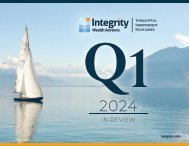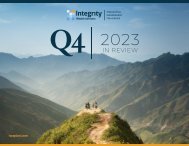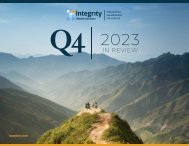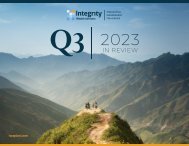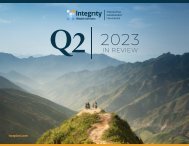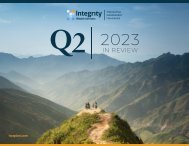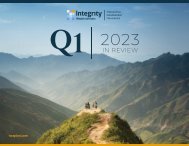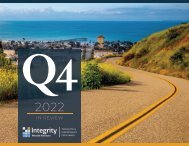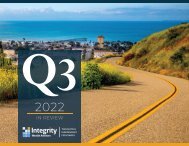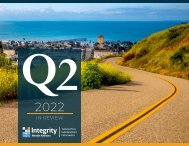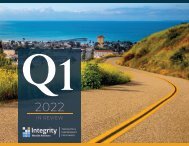2021 Q4 In Review - Integrity Wealth Advisors, Ventura | Ojai, California
As we kick off 2022, a substantial amount of uncertainty exists with many questions to be answered. Is the pandemic near its end? Will supply chain disruptions be resolved? How high will inflation go and how long will it last? Well the final numbers on inflation for 2021 are in, consumer prices continued their ascent in December, rising 0.5% for the month. Pushing the 12-month increase for the year of 2021 to 7.0%, the largest in nearly 40 years. Read more in our Q4 review.
As we kick off 2022, a substantial amount of uncertainty exists with many questions to be answered. Is the pandemic near its end? Will supply chain disruptions be resolved? How high will inflation go and how long will it last? Well the final numbers on inflation for 2021 are in, consumer prices continued their ascent in December, rising 0.5% for the month. Pushing the 12-month increase for the year of 2021 to 7.0%, the largest in nearly 40 years.
Read more in our Q4 review.
You also want an ePaper? Increase the reach of your titles
YUMPU automatically turns print PDFs into web optimized ePapers that Google loves.
<strong>Q4</strong> <strong>2021</strong><br />
IN REVIEW
TOTAL RETURN <strong>2021</strong> <strong>Q4</strong> + NEWSWORTHY EVENTS<br />
Oct 8 – Nearly 140<br />
countries agree to the<br />
biggest overhaul of<br />
global tax rules in a<br />
century, a move that<br />
aims to set a minimum<br />
15% corporate tax rate.<br />
Nov 3 – The Fed closes a<br />
chapter on its pandemicdriven<br />
stimulus, approving<br />
plans to begin scaling back<br />
its bond-buying program.<br />
Nov 26 – The WHO identifies a<br />
new coronavirus strain as a global<br />
“variant of concern,” and the Dow<br />
Jones average suffers its worst<br />
trading day of the year.<br />
Dec 10 – U.S. inflation hit a nearly<br />
four-decade high in November, the<br />
Labor Department says, as strong<br />
consumer demand collided with<br />
pandemic-related supply constraints.<br />
13%<br />
S&P 500 TOTAL RETURN<br />
Oct 28 – The U.S. economy, hurt<br />
by the virus surge and supply<br />
bottlenecks, grew at a 2% annual<br />
rate in the third quarter, the<br />
slowest pace since the recovery<br />
began in mid-2022.<br />
MSCI ACWI EX USA TOTAL RETURN<br />
Nov 15 – President Biden<br />
signs into law a roughly<br />
$1 trillion infrastructure<br />
package with spending on<br />
roads, bridges, rail and more.<br />
Dec 9 – The Labor<br />
Department reports that<br />
weekly jobless claims fell to<br />
the lowest level in more than<br />
half a century.<br />
BARCLAYS US AGGREGATE TOTAL RETURN<br />
Dec 19 – Sen. Joe Manchin (D.,<br />
W.Va.) says he will oppose his<br />
party’s roughly $2 trillion education,<br />
healthcare and climate package.<br />
11%<br />
9%<br />
11.02%<br />
7%<br />
5%<br />
3%<br />
1%<br />
-1%<br />
1.88%<br />
0.11%<br />
-3%<br />
October<br />
November<br />
December<br />
12%<br />
S&P 500 TOTAL RETURN<br />
MSCI ACWI EX USA TOTAL RETURN<br />
BARCLAYS US AGGREGATE TOTAL RETURN<br />
As of close 12/31/<strong>2021</strong><br />
11%<br />
10.42%
CAUTIOUSLY OPTIMISTIC FOR 2022<br />
<strong>2021</strong><br />
<strong>Q4</strong><br />
IN REVIEW<br />
As we kick off 2022, a substantial amount of uncertainty exists, with many<br />
questions to be answered. Is the pandemic near its end? Will supply chain<br />
disruptions be resolved? How high will inflation go, and how long will it last?<br />
Well, the final numbers on inflation for <strong>2021</strong> are in. Consumer prices continued<br />
their ascent in December, rising 0.5% for the month, thus pushing the 12 month<br />
increase for <strong>2021</strong> to 7.0%, the largest in nearly 40 years.<br />
While these numbers sound scary, we do not believe inflation to be as concerning<br />
as you might think. As more and more people are vaccinated or gaining natural<br />
immunity, the end to the pandemic finally feels like it is in sight. This should ease<br />
the supply chain woes that have been a big part of inflation. This, along with the<br />
Fed picking up the pace of tapering asset purchases and signaling a readiness<br />
for multiple rate hikes in 2022, lessens our concern that we will experience<br />
inflation like we did in the 1970’s. The piece of inflation that will not go away,<br />
however, is the 39% increase to the money supply, which will continue to increase<br />
over the course of the next year or so.<br />
We could see some short term volatility due to the midterms elections. An<br />
analysis of more than 90 years of equity returns reveals that stocks tend to have<br />
lower average returns and higher volatility for the first several months of midterm<br />
elections. Then, as the year unfolds, markets tend to return to their normal<br />
upward trajectory. On top of this, we have historically high levels of margin debt<br />
and increased retail trading. While we do not try to time the market, and neither<br />
should you, we can use volatility to our advantage and as a means to grow your<br />
wealth. Patience is important here, and proper asset allocation of your portfolio<br />
allows you the ability to be patient.<br />
The economy is currently weathering a tough period of the pandemic, due to the<br />
rapid transmission of the Omicron variant. But experts feel it’s affects should<br />
wane soon. The continued reopening of the economy, coupled with low interest<br />
rates even after some hikes, lead us to believe earnings growth will be strong. We<br />
are, however, in the 11th year of an extended bull market and some bumpiness is<br />
to be expected. Lean on your asset allocation and don’t panic when the volatility<br />
comes, because ultimately, our economic foundation is solid and healthy.<br />
ECONOMIC CHARTS & NOTES<br />
CONSUMER SENTIMENT Consumer sentiment reached a 10-year low<br />
in November as inflation concerns led some Americans to pare back their<br />
standard of living. Retail sales were up less than expected but still well above the<br />
pandemic-impacted level of 2020.<br />
EMPLOYMENT Job growth was strong in October but disappointing in<br />
November. Dubbed "The Great Resignation", a record 4.4 million people quit<br />
their jobs, a reflection of confidence in the labor market and rising interest<br />
in entrepreneurship. Despite the soft hiring data, the unemployment rate<br />
continued to slip to a new pandemic low.<br />
US Retail Sales<br />
Consumer Sentiment<br />
Unemployment Rate<br />
NonFarm Payroll<br />
34%<br />
100<br />
16%<br />
2200<br />
US Retail Sales % Chg<br />
28%<br />
22%<br />
16%<br />
10%<br />
4%<br />
-2%<br />
-8%<br />
95<br />
90<br />
85<br />
80<br />
75<br />
Consumer Sentiment<br />
Unemployment Rate %<br />
14%<br />
12%<br />
10%<br />
8%<br />
6%<br />
4%<br />
-825<br />
-3850<br />
-6875<br />
-9900<br />
-12925<br />
-15950<br />
-18975<br />
NonFarm Payroll<br />
-14%<br />
Jan '19<br />
Jul '19<br />
Jan '20<br />
Jul '20<br />
Jan '21<br />
Jul '21<br />
70<br />
2%<br />
Jan ' 19<br />
Jul '19<br />
Jan '20<br />
Jul '20<br />
Jan '21<br />
Jul '21<br />
-22000
ECONOMIC CHARTS & NOTES<br />
CONSUMER PRICE INDEX U.S. inflation surged 7% for <strong>2021</strong>, marking<br />
the highest rate since 1982. Rising food, energy, and housing prices were<br />
responsible for much of the jump as pressure mounted on the Fed to take a<br />
more aggressive monetary policy stance.<br />
Amount in Thousands Y/Y % Chg<br />
7%<br />
6%<br />
5%<br />
4%<br />
3%<br />
2%<br />
1%<br />
0%<br />
Jan ' 18<br />
JOB OPENINGS & HIRES Retail hiring slowed even ahead of the holiday<br />
shopping season, but job gains were solid in the professional services,<br />
transportation, and construction industries. Job openings remained above one<br />
million for the sixth straight month as retailers struggled to attract workers.<br />
1200<br />
1000<br />
800<br />
600<br />
400<br />
200<br />
0<br />
Jan '18<br />
Jul '18<br />
CPI Less Food<br />
Jul '18 Jan ' 19<br />
Retail Hires<br />
Jan '19<br />
Jul '19<br />
Jul '19<br />
Jan '20<br />
Jan '20<br />
Jul '20<br />
CPI All<br />
Jul '20<br />
Retail Openings<br />
Jan '21<br />
Jan '21<br />
Jul '21<br />
Jul '21<br />
CONSUMER SPENDING Real disposable personal income, the money<br />
consumers have left to save or spend after taxes (adjusted for inflation), was<br />
flat in November. Still, consumer spending accelerated in <strong>Q4</strong> helping overall<br />
economic growth do the same.<br />
% Chg Year-over-year<br />
GDP Real GDP growth is expected to have strengthened in <strong>Q4</strong> after coming in at<br />
2.3% in Q3. Economists are forecasting healthy, yet modest, growth in Q1 2022 due<br />
to lingering inflation, supply chain disruptions, and a resurgence of COVID cases.<br />
% Growth<br />
30<br />
25<br />
20<br />
15<br />
10<br />
5<br />
0<br />
-5<br />
-10<br />
-15<br />
Jan '19<br />
35%<br />
30%<br />
25%<br />
20%<br />
15%<br />
10%<br />
5%<br />
0%<br />
-5%<br />
-10%<br />
-15%<br />
-20%<br />
-25%<br />
-30%<br />
-35%<br />
2017<br />
Jul '19<br />
Consumption<br />
Jan '20<br />
Jul ' 20<br />
GDP<br />
Jan '21<br />
Disposable <strong>In</strong>come<br />
Jul '21<br />
Q1 Q2 Q3 <strong>Q4</strong> Q1 Q2 Q3 <strong>Q4</strong> Q1 Q2 Q3 <strong>Q4</strong> Q1 Q2 Q3 <strong>Q4</strong> Q1 Q2 Q3<br />
2018 2019 2020 <strong>2021</strong>
CONSUMER SPENDING DURING BLACK<br />
FRIDAY AND CYBER MONDAY<br />
<strong>2021</strong><br />
<strong>Q4</strong><br />
IN REVIEW<br />
Online sales during <strong>2021</strong>’s Black Friday and<br />
Cyber Monday shopping holidays ended up being<br />
slightly less than those of the previous year, the<br />
first time such a decrease has been recorded.<br />
Americans shelled out $8.9 billion on Black Friday<br />
deals and $10.7 billion on Cyber Monday specials,<br />
compared to $9 billion and $10.8 billion in 2020,<br />
according to Adobe Analytics.<br />
U.S. HOLIDAY SALES SLIP FOR THE FIRST TIME EVER<br />
E-Commerce Revenue, in Billions<br />
2018<br />
2019<br />
2020<br />
<strong>2021</strong><br />
$6.2<br />
$7.4<br />
$9.0<br />
$8.9<br />
$7.9<br />
$9.4<br />
$10.8 $10.7<br />
Consumer spending makes up about 70% of<br />
the U.S. economy, so some may interpret these<br />
results as a worrisome sign of things to come.<br />
However, the only reason Americans didn’t set a<br />
new sales record last November for the shopping<br />
holidays is likely that they had been spreading<br />
out their discretionary spending throughout the<br />
year. Unlike years past, people appear not to<br />
have waited for Black Friday deals to buy a new<br />
TV, update their kitchen appliances or splurge<br />
on luxury goods. What’s more, many retailers<br />
introduced discounts much earlier than usual.<br />
November’s Adobe data confirms this.<br />
Throughout the month, Americans spent $109.8<br />
billion online, a 12% increase over November<br />
2020. Adobe adds that 22 days of the month<br />
exceeded $3 billion in shopping, a new milestone.<br />
Consumption in the U.S. grew $214.3 billion, or<br />
1.3%, from September to October, marking the<br />
eighth straight month that personal expenditures<br />
increased.<br />
The pandemic has largely contributed to heavier<br />
consumption. Supported by low rates, easy<br />
money and rising wages, consumers have by and<br />
large shifted much of their discretionary spending<br />
from experiences (dining out, movies, concerts)<br />
to merchandise.<br />
Black Friday<br />
Cyber Monday<br />
Source: Adobe Digital <strong>In</strong>sights, U.S. Global <strong>In</strong>vestors<br />
CONSUMPTION RECOVERED QUICKLY AS AMERICANS SHIFTED SPENDING FROM SERVICES TO GOODS<br />
Personal Consumption Expenditures in Billions, 5-Year Period through October <strong>2021</strong><br />
$17,000<br />
$16,000<br />
$15,000<br />
$14,000<br />
$13,000<br />
$12,000<br />
JAN 2017 JUL 2017 JAN 2018 JUL 2018 JAN 2019 JUL 2019 JAN 2020 JUL 2020 JAN <strong>2021</strong> JUL <strong>2021</strong><br />
Source: Adara, U.S. Global <strong>In</strong>vestors
GET READY FOR SOME VOLATILITY THIS<br />
MIDTERM ELECTION YEAR<br />
Some economists believe 2022 could be one of the more consequential midterm elections in U.S. history. While the election is still nearly a year away, history<br />
suggests that we will see a backlash against the party in power that will result in Republicans taking back control of the House and potentially the Senate.<br />
This possibility isn't lost on Democrats. <strong>In</strong> the months ahead, they will likely continue to push for ambitious new spending programs as well as higher taxes<br />
for corporations and wealthy individuals. However, expect these progressive goals to be tempered by the political reality of the party's slender majorities in<br />
the House and Senate.<br />
Still, political uncertainty often<br />
has a noticeable short-term<br />
effect on markets. An analysis<br />
of more than 90 years of equity<br />
returns reveals that stocks<br />
tend to have lower average<br />
returns and higher volatility<br />
for the first several months<br />
of midterm election years. As<br />
results at the polls become<br />
more predictable, this trend<br />
often reverses and markets<br />
have tended to return to their<br />
normal upward trajectory.<br />
<strong>In</strong>vestors should keep in mind,<br />
however, that these are just<br />
averages, and shouldn't try to<br />
time an entry point into the<br />
market.<br />
S&P 500 INDEX AVERAGE RETURNS SINCE 1931<br />
Midterm elections - and politics<br />
as a whole - generate a lot of<br />
noise. Prudent investors are<br />
wise to look past the shortterm<br />
highs and lows and<br />
maintain a long-term focus.<br />
Sources: Capital Group, RIMES, Standard & Poor's. The chart shows the average trajectory of equity returns throughout midterm election years compared to non-midterm election years. Each point on the lines represents<br />
the average year-to-date return as of that particular month and day, and is calculated using daily price returns from 1/1/31-11/30/21.
HIGH INFLATION SHOULD PERSIST IN 2022,<br />
BUT WE'RE NOT RETURNING TO THE 1970s<br />
<strong>2021</strong><br />
<strong>Q4</strong><br />
IN REVIEW<br />
<strong>In</strong>flation is like chewing gum. It's sticky and flexible, and you wouldn’t want to step in it.<br />
For the past 30 years, investors haven't had to worry much about stepping in it. That changed last summer when COVID-related distortions caused prices for some<br />
consumer goods to skyrocket. Today, the biggest questions for investors are how high will it go and how long will it last?<br />
Adding to the uncertainty is that there are two types of inflation. Sticky inflation tends to have longer staying power. Sticky categories include rent, insurance and<br />
medical expenses. Flexible inflation - affecting items such as food, energy and cars - has risen much faster in recent months but many believe it won't last.<br />
We feel that the risk is in the sticky components and that those are the categories that will drive inflation in 2022. While we expect inflation to eventually return to<br />
normal levels, we do think it is prudent to guard against sustained higher prices in your portfolio.<br />
STICKY AND FLEXIBLE PRICE INFLATION, YOY CHANGE %<br />
INFLATION<br />
PROJECTIONS<br />
Sources: Capital Group.Federal Reserve Bank of Atlanta, Refinitiv Datastream. Sticky and flexible prices reflect the Atlanta Federal Reserve sticky and flexible consumer price indexes (CPI). If price changes for a particular<br />
CPI component occur less than every 4.3 months, that component is a "sticky-price" good. Goods that change prices more frequently are "flexible-price" goods. Historic data is through November <strong>2021</strong>. Projections for<br />
<strong>2021</strong>-2023 are from IMF and as of October <strong>2021</strong>.
YOU’RE NOT GOING TO BEAT INFLATION IN YOUR SAVINGS ACCOUNT<br />
<strong>In</strong> December, the Bureau of Labor Statistics (BLS) reported that<br />
consumer prices rose at their fastest annual pace in about 40 years.<br />
The consumer price index (CPI) increased 7% year-over-year in<br />
December, the highest reading since June 1982. Among the biggest<br />
contributors to higher inflation were gasoline (up 58.1%), natural gas<br />
(25.1%), used cars and trucks (31.4%) and clothing (5%).<br />
It’s slightly distressing to look at this chart, which shows that the<br />
total value of deposits in U.S. commercial banks is about to exceed<br />
$18 trillion. <strong>In</strong>flation is melting away people’s cash faster than the<br />
Federal Reserve can print more of it. Low interest rates have made it<br />
even more difficult to breakeven with inflation this last year. The only<br />
sure way to lose against inflation is to leave your money in a savings<br />
account.<br />
Sources: IEA, JPMorgan, U.S. Global <strong>In</strong>vestors. Five-Year period through November <strong>2021</strong><br />
DEPOSITS AT U.S. COMMERCIAL BANKS SOON TO EXCEED A RECORD $18 TRILLION<br />
$18<br />
$17.89 Trillion<br />
$17<br />
$16<br />
$15<br />
$14<br />
$13<br />
$12<br />
$11<br />
JAN 2017 JUL 2017 JAN 2018 JUL 2018 JAN 2019 JUL 2019 JAN 2020 JUL 2020 JAN <strong>2021</strong> JUL <strong>2021</strong><br />
RETAIL TRADING BOOM<br />
A year ago, so-called ‘retail traders’ were a quirky sideshow in U.S.<br />
stocks, fending off the boredom of coronavirus lockdowns by dabbling<br />
in markets essentially fee-free, thanks to a price war kicked off by<br />
Robinhood in 2019. Under the online rallying cry that “stocks only go up”,<br />
they demonstrated an optimism about economic outlook that was often<br />
lacking among professional fund managers, pumping up some stocks<br />
that others would not touch. They ended up piggybacking on a historic<br />
rally in equities that has now been running for nearly a year.<br />
MARKET SHARE OF OVERALL US EQUITY TRADING VOLUMES (%)<br />
Retail<br />
Quant Hedge Funds<br />
Mutual Funds<br />
Traditional Hedge Funds<br />
Bank Trading<br />
High-Frequency Market-Makers<br />
50<br />
40<br />
Few in the investment industry took this long-maligned “dumb money”<br />
seriously. Credit Suisse estimates that at times this year they have<br />
accounted for a third of all US stock market trading. The burning question<br />
on Wall Street is whether this burst of hyperactive retail trading is a<br />
temporary coronavirus-inspired phenomenon that will inevitably ebb once<br />
markets next crash — as happened after the dotcom boom and bust — or<br />
the start of a new regime driving the US stock market.<br />
Source: Bloomberg <strong>In</strong>telligence<br />
Retail trading<br />
begins to take<br />
off again<br />
2010 2011 2012 2013 2014 2015 2016 2017 2018 2019 2020 <strong>2021</strong><br />
30<br />
20<br />
10<br />
0
INVESTOR CREDIT AND THE MARKET<br />
<strong>2021</strong><br />
<strong>Q4</strong><br />
IN REVIEW<br />
Let's examine the chart below, and study the relationship between margin debt<br />
and the market, using the S&P 500 as the surrogate for the latter.<br />
five months later, in August. A similar surge began in 2006, peaking in July 2007,<br />
three months before the market peak.<br />
At the 1997 start date, we were well into the Boomer Bull Market that began<br />
in 1982 and approaching the start of the Tech Bubble that shaped investor<br />
sentiment during the second half of the decade. The astonishing surge in<br />
leverage in late 1999 peaked in March 2000, the same month that the S&P 500<br />
hit its all-time daily high, although the highest monthly close for that year was<br />
500,000<br />
<strong>In</strong>vestor Credit and the Market<br />
Debt hit a trough in February 2009, a month before the March market bottom. It<br />
then began another major cycle of increases. FINRA has released new data for<br />
margin debt, now available through November <strong>2021</strong>. The latest debt level is down<br />
1.84% month-over-month, but still near record highs. This has been an interesting<br />
indicator to watch and will certainly continue to bear close watching in the future.<br />
5000<br />
400,000<br />
Credit Balance is calculated as the sum of Free Credit Cash Accounts and Credit Balances in Margin Accounts minus Margin Debt.<br />
Note: Latest data as of November <strong>2021</strong>. As of Dec 2017, data is calculated using FINRA data, which includes NYSE firms.<br />
4500<br />
300,000<br />
Positive Credit Balance Negative Credit Balance S&P 500<br />
4000<br />
200,000 $200<br />
3500<br />
100,000 $100<br />
3000<br />
Billions<br />
0<br />
2500<br />
-100, -$100 000<br />
2000<br />
-200, -$200 000<br />
1500<br />
-300, -$300 000<br />
1000<br />
-400, -$400 000<br />
500<br />
-500, -$500 000<br />
1<br />
6<br />
11<br />
16<br />
21<br />
26<br />
31<br />
36<br />
41<br />
46<br />
51<br />
56<br />
61<br />
66<br />
71<br />
76<br />
81<br />
86<br />
91<br />
96<br />
101<br />
106<br />
111<br />
116<br />
121<br />
126<br />
131<br />
136<br />
1997 1998 1999 2000 2001 2002 2003 2004 2005 2006 2007 2008 2009 2010 2011 2012 2013 2014 2015 2016 2017 2018 2019<br />
141<br />
146<br />
151<br />
156<br />
161<br />
166<br />
171<br />
Credit Bal ance S&P 500<br />
176<br />
181<br />
186<br />
191<br />
196<br />
201<br />
206<br />
211<br />
216<br />
221<br />
226<br />
231<br />
236<br />
241<br />
246<br />
251<br />
256<br />
261<br />
266<br />
271<br />
276<br />
281<br />
286<br />
291<br />
296<br />
2020 <strong>2021</strong><br />
0
INVESTMENT<br />
MANAGEMENT<br />
PHILOSOPHY<br />
The complex, ever-changing investment world of today<br />
requires an investment process that is overseen by a team<br />
of experienced investment professionals. Global capital<br />
markets present investors with a host of challenges due to<br />
the combination of an overwhelming amount of information<br />
to analyze and the endless supply of conflicting opinions and<br />
narratives surrounding financial markets. The time and expertise<br />
required to perform in-depth investment research and to make<br />
timely and informed portfolio management decisions requires<br />
both a clear investment process and an experienced investment<br />
team to implement the process.<br />
An old adage states that there is accomplishment through<br />
many advisors. We agree and embrace a variety of investment<br />
perspectives through our investment committee. Our investment<br />
philosophy is well grounded in global macro-economic analysis.<br />
<strong>In</strong>vestment ideas are carefully vetted through a process which<br />
incorporates the diverse range of investment backgrounds<br />
within our firm. This process of multifaceted analysis ensures<br />
that only the strongest investment ideas survive. We are<br />
committed to striking the right balance between risk and<br />
return through managing global, multi-asset class investment<br />
portfolios.<br />
INDEPENDENCE &<br />
CLIENT FOCUS<br />
DIVERSIFICATION<br />
TOP-DOWN, THEMATIC<br />
APPROACH<br />
PERFORMANCE WITH<br />
LIQUIDITY<br />
VARIED INVESTMENT<br />
PERSPECTIVES<br />
OPTIMIZATION OF<br />
EXPENSES AND TAXES<br />
THE INVESTMENT PROCESS<br />
ASSESSMENT OF GLOBAL<br />
ECONOMIC & INVESTMENT<br />
ENVIRONMENT<br />
ASSESS & ANALYZE<br />
THEMES<br />
RESEARCH INVESTMENT<br />
VEHICLES TO FIND<br />
EFFECTIVE IMPLEMENTATION<br />
IDENTIFY<br />
OPPORTUNITIES<br />
STRATEGIC ASSET<br />
ALLOCATION -<br />
Geographies, Sectors,<br />
Capitalizations<br />
INVESTMENT SELECTION -<br />
Open/Closed End Funds, ETFs, Stocks & Bonds
INVESTMENT COMMITTEE<br />
<strong>2021</strong><br />
<strong>Q4</strong><br />
IN REVIEW<br />
The <strong>In</strong>vestment Committee meets formally<br />
each quarter, and more frequently if market<br />
conditions warrant, to discuss the state of<br />
the global economy and capital markets and<br />
to assess the current asset allocation and<br />
positioning of our portfolios. There’s an art<br />
to striking the right balance between risk and<br />
return; pursuing that symmetry is the core of<br />
our investment philosophy. We are fiduciaries<br />
and have our interests aligned with our<br />
clients, as we invest alongside them.Contact<br />
us at investmentcommittee@iwaplan.com<br />
with any questions or concerns.<br />
STEPHEN WAGNER<br />
CEO, <strong>In</strong>vestment Advisor,<br />
CFP ® , CPFA<br />
35+ Years Experience*<br />
VICTORIA BREEN<br />
<strong>In</strong>vestment Advisor &<br />
Financial Planner<br />
40+ Years Experience*<br />
MARTHA LAFF<br />
<strong>In</strong>vestment Advisor,<br />
ChFC ® , CLU ® , CRPC ®<br />
30+ Years Experience*<br />
ANDREW MURTHA<br />
Financial Analyst,<br />
MBA<br />
20+ Years Experience*<br />
BOB CHEATHAM<br />
Financial Planner,<br />
CRPS®, MA<br />
MARGARET MARAPAO<br />
<strong>In</strong>vestment Advisor &<br />
Financial Planner, CFP ®<br />
CHRISTOPHER WAGNER<br />
<strong>In</strong>vestment Advisor &<br />
Financial Planner, CPFA<br />
LAINE MILLER<br />
<strong>In</strong>vestment Advisor &<br />
Financial Planner<br />
DOUG ECKER<br />
<strong>In</strong>vestment Advisor &<br />
Financial Planner, CRPS®<br />
15+ Years Experience*<br />
* Financial services experience. <strong>In</strong>vestment Advisory Services are offered through investment advisor representatives of <strong>In</strong>tegrity <strong>Wealth</strong> <strong>Advisors</strong>, a Federally Registered <strong>In</strong>vestment Advisor.<br />
THOUGHTFUL<br />
INDEPENDENT<br />
FIDUCIARIES<br />
<strong>In</strong>tegrity <strong>Wealth</strong> <strong>Advisors</strong> has<br />
been committed to helping<br />
individuals, families, and<br />
businesses grow, preserve, and<br />
distribute wealth since 1979<br />
VENTURA<br />
196 S Fir St, Ste 140<br />
<strong>Ventura</strong>, CA 93001<br />
(805) 339-0760<br />
ventura@iwaplan.com<br />
OJAI<br />
603 West <strong>Ojai</strong> Ave #C<br />
<strong>Ojai</strong>, CA 93023<br />
(805) 646-3729<br />
ojai@iwaplan.com
THE IMPACT OF<br />
SOUND FINANCIAL<br />
PLANNING<br />
Recent Vanguard research 1 shows that an experienced<br />
wealth management team not only adds peace of mind,<br />
but also may add about 3 percentage points of value in<br />
net portfolio returns over time. What does this mean? Your<br />
team has the ability and the time to evaluate your portfolio<br />
investments, meet with you to discuss objectives, and<br />
help get you through tough markets. All of these factored<br />
together potentially add value to your net returns (returns<br />
after taxes and fees) over time. But the most interesting part<br />
of this research is that it shows that financial planning and<br />
financial coaching contributed to the greater majority of the<br />
added net 3% in net portfolio returns.<br />
It’s important to realize how valuable making sound financial<br />
planning decisions is and that value is added by your<br />
financial planning team. As investors, our emotions can be<br />
our worst enemy, especially when the markets are volatile,<br />
and guidance from a “behavioral coach” can save us from<br />
panic-selling and abandoning long-term financial plans.<br />
Numerous studies demonstrate that advisors can have a<br />
huge impact on investor finances, but it’s hard to say if these<br />
findings have been recognized and understood by everyday<br />
investors.<br />
DREAM.<br />
PLAN.<br />
ENJOY.<br />
TWO REPAYMENT STRATEGIES TO<br />
PAY DOWN DEBT EFFECTIVELY<br />
Pay debts down in order of balance<br />
amount.<br />
Pay the minimum payment on higher<br />
balance debt and shift those dollars<br />
to the lowest balance debt.<br />
Once the lowest balance debt is paid<br />
off, shift funds to the next lowest<br />
balance debt.<br />
BENEFIT:<br />
QUICK SATISFACTION<br />
THE<br />
Debt Avalanche<br />
METHOD<br />
Pay debts down in order of interest rate.<br />
Pay the minimum payment on lower interest<br />
debt and shift those dollars to the highest<br />
interest debt.<br />
Once the highest debt is paid off, shift funds<br />
to the next highest interest rate.<br />
BENEFIT:<br />
PAY DEBTS OFF FASTER<br />
AND PAY LESS INTEREST<br />
VS<br />
THE<br />
Debt Snowball<br />
METHOD
ESTATE PLANNING CHECKLIST<br />
We'll walk you through how to create and formalize your estate plan with our 4-step estate planning checklist.<br />
1 2 3 4<br />
TAKE INVENTORY<br />
No matter how modest, everything<br />
you own is considered your estate.<br />
Taking stock of what you own is the<br />
first step in understanding how best<br />
to protect it. To start your estate<br />
plan:<br />
List the value of your home and<br />
other real estate along with<br />
cars, jewelry, artwork, and other<br />
physical assets.<br />
Gather recent statements<br />
from your bank, brokerage, and<br />
retirement accounts.<br />
<strong>In</strong>clude the location and contents<br />
of any safety deposit boxes or<br />
safes.<br />
Make a list of all insurance<br />
policies, noting their cash values<br />
and death benefits.<br />
List all liabilities, including<br />
mortgages, lines of credit, and<br />
other debt.<br />
DRAFT YOUR ESTATE PLAN<br />
Prepare to meet with an estate<br />
planning attorney by answering<br />
these important questions about<br />
how to settle your affairs:<br />
Who should inherit your assets,<br />
and in what proportions?<br />
Who should care for your minor<br />
children?<br />
How much is needed for your<br />
children's care and education?<br />
Who should manage your<br />
financial affairs if you become<br />
incapacitated?<br />
Who should be responsible for<br />
distributing your assets?<br />
PUT YOUR ESTATE PLAN INTO<br />
ACTION<br />
When you're ready, meet with an<br />
estate planning attorney to draft<br />
your will, medical and financial<br />
powers of attorney, and trust<br />
documents, if applicable. Keep the<br />
tips below in mind.<br />
If you set up a trust, fund it<br />
promptly and retitle ownership of<br />
eligible accounts and property.<br />
<strong>Review</strong> and update the<br />
beneficiaries on all of your<br />
investment accounts.<br />
UPDATE YOUR ESTATE PLAN<br />
REGULARLY<br />
<strong>Review</strong> and update your documents<br />
and accounts as your situation<br />
changes or as current laws change.<br />
Keep your beneficiary<br />
designations up-to-date so that<br />
your assets will be distributed<br />
according to your wishes.<br />
Call us to schedule a meeting.<br />
We can refer you to several<br />
highly respected estate planning<br />
attorneys, and help you to prepare<br />
to work with them.
HELPING ELDERLY PARENTS WITH THEIR FINANCES<br />
Some might say that 80 is the new 60, but the reality of aging is that no matter how young your parents feel now, they’re likely to need some type of help in<br />
the future. We applaud you for being proactive—it’s better to have these difficult conversations before a change in your parents’ situation necessitates your<br />
involvement.<br />
HERE ARE FIVE TIPS TO HELP BROACH THE SUBJECT:<br />
1 Ask about their financial security<br />
A lot of people don’t like to talk about money, but if you come from a position of<br />
concern, they might feel more comfortable. Here are some questions to start with:<br />
• How are they handling everyday expenses? Do they have enough income to cover the<br />
essentials? If they’re struggling to stay on top of bills or debts, you might help them<br />
create a more realistic budget or suggest they work with a planner who can help them<br />
to get a handle on their expenses.<br />
• Do they have a financial advisor? If so, ask if they’d be willing to introduce you and<br />
perhaps even include you in a meeting. If they don’t have an advisor, you can start by<br />
encouraging them to meet with one.<br />
• Do they have a complete estate plan? Chances are, your parents have a will and perhaps<br />
even some asset titling in place, but what about health care directives and powers<br />
of attorney? Ask whether they’ve created any legal documents that specify how to<br />
manage their financial and health care decisions should they become unable to do<br />
so themselves. If they do have a solid plan in place, ask when they last reviewed the<br />
documents and whether any updates are necessary.<br />
• Are important documents accessible? <strong>In</strong> case of emergency, it’s important that you<br />
or another trusted person be able to locate important documents, such as financial<br />
statements, insurance policies, trust paperwork, and wills. If they don’t have it all in<br />
one place, ask if you can help them collect and store the documents for safekeeping.<br />
2<br />
Discuss future living<br />
arrangements<br />
Some people want to live in their<br />
homes as long as they can, while<br />
others are open to independentliving<br />
communities should their<br />
health decline. Ask your parents if<br />
they’ve thought about what they<br />
might do in the event they need<br />
ongoing help. Position it as just an<br />
exploration of future possibilities—<br />
not a recommendation.<br />
3<br />
Plan for long-term care<br />
The median annual cost for assisted living is $51,600,<br />
according to the Genworth 2020 Cost of Care Survey.<br />
However, median annual costs vary widely by location—<br />
for example the median cost is $70,140 here in <strong>Ventura</strong><br />
County. Not everyone will need long-term care, of course,<br />
but it’s still worth discussing. If your parents already have<br />
long-term care insurance, understand what it will cover.<br />
While future care can be an emotional flashpoint, it’s also<br />
an important financial consideration because they—and<br />
you—need to understand how much they can afford and<br />
whether you might need to supplement any costs.<br />
4<br />
Be on alert for abuse<br />
If you have siblings, make sure everyone is aware of your parents’<br />
situation and desires, and come to a consensus on who will<br />
do what, should your parents need assistance in the future.<br />
<strong>In</strong> this way, you can ensure there are no misunderstandings<br />
or disagreements and that whomever takes the lead gets the<br />
support they need.<br />
Be sure to discuss this with your parents, too. As a precaution,<br />
you might suggest they add you or another trusted family<br />
member to some or all of their accounts to help monitor balances<br />
and transactions.<br />
5<br />
Have a family discussion<br />
If you have siblings, make sure everyone is<br />
aware of your parents’ situation and desires,<br />
and come to a consensus on who will do what<br />
should your parents need assistance in the<br />
future. <strong>In</strong> this way, you can ensure there are no<br />
misunderstandings or disagreements and that<br />
whoever takes the lead gets the support they<br />
need.<br />
Finally, when it comes to family financial<br />
conversations, it is all about talking openly and<br />
honestly. While the burden often falls on the kids<br />
to get the conversation going, we encourage<br />
any older adults reading this to initiate these<br />
discussions themselves. The more mutual<br />
understanding there is about the future—<br />
regarding both emotional and financial matters—<br />
the more you will all be able to enjoy the present.
FINANCIAL PLANNING FOR YOUR NEXT MOVE<br />
Americans are pulling up stakes, motivated in part by the shift to remote work, which moved from the exception to the rule over the past year. <strong>In</strong>deed, between 14<br />
and 23 million people were expected to have moved in <strong>2021</strong>, both to take advantage of new work-from-home opportunities and to escape the rising cost of living in<br />
many major cities. Regardless of your reasons for moving, it pays to do some financial and tax planning long before you start packing. With that in mind, here are<br />
four common mistakes to avoid when making your next big move.<br />
MISTAKE NO. 1:<br />
UNDERESTIMATING HOUSING COSTS<br />
MISTAKE NO. 2:<br />
UNDERESTIMATING TAXES<br />
MISTAKE NO. 3:<br />
UNDERESTIMATING COST OF LIVING<br />
MISTAKE NO. 4:<br />
OVERESTIMATING JOB PROSPECTS<br />
Housing costs are going to be the<br />
core component of your budget. <strong>In</strong><br />
particular, be sure to investigate:<br />
Homeowners insurance: As with any<br />
type of insurance, premiums will vary<br />
widely by company and coverage.<br />
Supplemental insurance: Will you<br />
require additional policies, such as<br />
flood or earthquake insurance?<br />
Property taxes: For a realistic<br />
estimate, ask your broker how your<br />
new city or county determines<br />
property taxes and how often it<br />
conducts reassessments.<br />
Utilities: Electricity, internet, natural<br />
gas, sewer, trash, water—such costs<br />
can add up quickly and vary widely by<br />
location.<br />
Taken together, the above costs can<br />
easily account for half or more of your<br />
total housing budget, so be realistic<br />
when estimating expenses. Ideally<br />
you don’t want to pay more than 28%<br />
of your pretax income toward total<br />
housing costs.<br />
The tax consequences of moving can<br />
be significant—especially if you’re<br />
switching states. For instance, you<br />
may still be on the hook for income,<br />
payroll, and/or property taxes in<br />
your former state, particularly if you<br />
maintain a home or business ties.<br />
Employees working outside their<br />
employer’s state can also be subject<br />
to dual taxation, perhaps permanently.<br />
It’s also important to consider<br />
a state’s total tax structure. For<br />
instance, a state with no income tax<br />
may compensate with higher estate,<br />
property, and/or sales taxes.<br />
You should also look into estate<br />
taxes. While the federal exemption is<br />
currently $11.7 million ($23.4 million<br />
for married couples) some states tax<br />
estates starting at $1 million.<br />
A lot of people assume their everyday<br />
expenses will largely stay the same<br />
when they relocate to a new area, but<br />
that’s not always the case. Depending<br />
on your needs, consider the cost of:<br />
Child care: For working parents, the<br />
cost of full-time day care can rival a<br />
mortgage payment.<br />
Health care: If your employer offers<br />
health insurance, medical expenses<br />
may be less of a consideration for<br />
you—though, like everything else,<br />
costs vary widely by area and provider.<br />
Transportation: Beyond the cost of<br />
gasoline, which can vary by a dollar or<br />
more per gallon, consider the price of<br />
car insurance and registration.<br />
Food: It may sound incidental, but<br />
the cost of groceries can also vary<br />
widely. A gallon of milk, for example,<br />
costs as much as $4.69 in Hawaii<br />
and as little as $0.93 in Illinois. And if<br />
you’ll be living in an area with limited<br />
agriculture, expect to pay more for<br />
fresh fruits and vegetables.<br />
Finally, be sure that your combined<br />
living expenses don’t undermine<br />
your ability to save for the future. For<br />
example, a good rule of thumb is to<br />
set aside at least 10% to 15% of your<br />
income for retirement.<br />
Many people have a job lined up<br />
before they move, but you should<br />
still do a thorough assessment of<br />
the employment market in your area<br />
of expertise. What happens if your<br />
company downsizes or you want to<br />
change your employer or career path?<br />
It’s always good to plan for change.<br />
Also be sure to educate yourself<br />
about your new state’s employment<br />
laws—including dependent benefits,<br />
discrimination prohibitions, and labor<br />
protections.<br />
Beyond dollars and cents, if your<br />
due diligence has you questioning<br />
the merits of a move, it’s perfectly<br />
reasonable to stay put—or to reassess<br />
your goals. Of course, even a move<br />
that increases your taxes or overall<br />
cost of living can still be worthwhile<br />
if it offers a better quality of life. After<br />
all, moving isn’t just about money.
VENTURA<br />
196 S Fir St, Ste 140<br />
<strong>Ventura</strong>, CA 93001<br />
(805) 339-0760<br />
ventura@iwaplan.com<br />
OJAI<br />
603 West <strong>Ojai</strong> Ave #C<br />
<strong>Ojai</strong>, CA 93023<br />
(805) 646-3729<br />
ojai@iwaplan.com<br />
Data / statistics cited are provided by the Federal Reserve Bank of St. Louis.<br />
The S&P 500 <strong>In</strong>dex or the Standard & Poor's 500 <strong>In</strong>dex is a market-capitalization-weighted index of the 500 largest U.S. publicly traded companies. The S&P<br />
500 is a float-weighted index, meaning company market capitalizations are adjusted by the number of shares available for public trading. <strong>In</strong>vestors cannot<br />
invest directly in an index. Note: <strong>In</strong>vestors cannot invest directly in an index. These unmanaged indices do not reflect management fees and transaction<br />
costs that are associated with most investments.<br />
The MSCI World ex USA <strong>In</strong>dex captures large and mid cap representation across 22 of 23 Developed Markets (DM) countries* – excluding the United States.<br />
With 1,012 constituents, the index covers approximately 85% of the free float-adjusted market capitalization in each country.<br />
The Barclays Capital U.S. Aggregate Bond <strong>In</strong>dex is the most common index used to track the performance of investment grade bonds in the U.S.<br />
The opinions expressed in this program are for general informational purposes only and are not intended to provide specific advice or recommendations<br />
for any individual or on any specific security. It is only intended to provide education about the financial industry. To determine which investments may be<br />
appropriate for you, consult your financial advisor prior to investing. Any past performance discussed during this program is no guarantee of future results.<br />
Any indices referenced for comparison are unmanaged and cannot be invested into directly. <strong>In</strong>vesting involves risk and possible loss of principal capital;<br />
please seek advice from a licensed professional.<br />
<strong>In</strong>tegrity <strong>Wealth</strong> <strong>Advisors</strong> is a registered investment adviser. Advisory services are only offered to clients or prospective clients where <strong>In</strong>tegrity <strong>Wealth</strong><br />
<strong>Advisors</strong> and its representatives are properly licensed or exempt from licensure. No advice may be rendered by <strong>In</strong>tegrity <strong>Wealth</strong> <strong>Advisors</strong> unless a client<br />
service agreement is in place.<br />
Vanguard research study; Source: Francis M. Kinniry Jr., Colleen M. Jaconetti, Michael A. DiJoseph, and Yan Zilbering, 2014. Putting<br />
a value on your value: Quantifying Vanguard Advisor’s Alpha. Valley Forge, Pa.: The Vanguard Group.<br />
Securities offered through LPL Financial, Member FINRA/SIPC. A separate entity from <strong>In</strong>tegrity <strong>Wealth</strong> <strong>Advisors</strong>.




